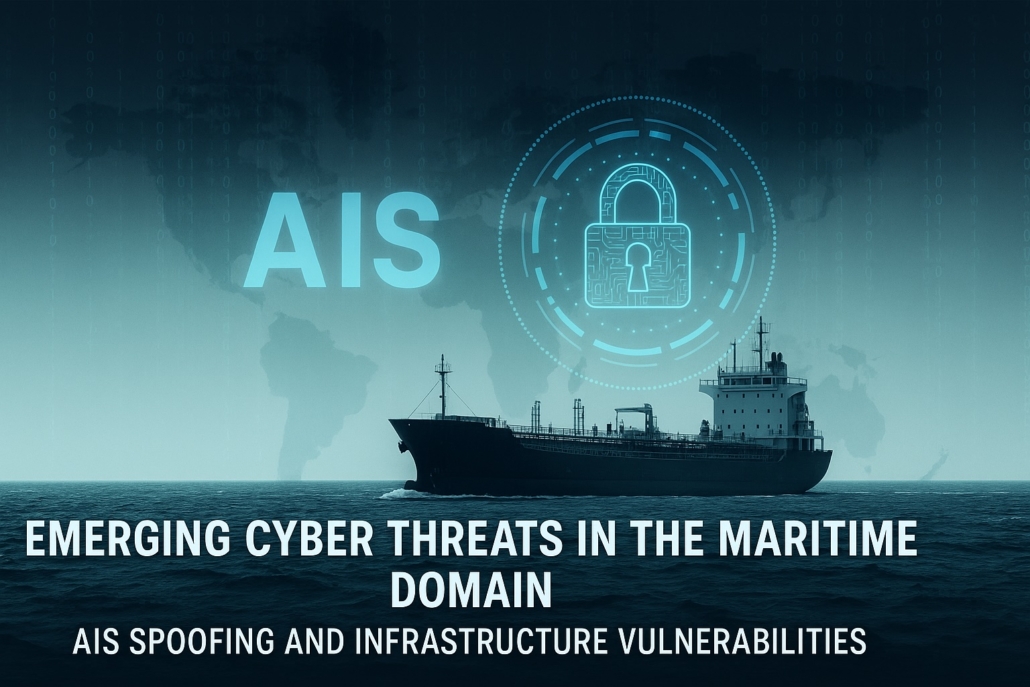Emerging Cyber Threats in the Maritime Domain: AIS Spoofing and Infrastructure Vulnerabilities

AIS Spoofing and Cyber Threats Pose New Risks to Maritime Infrastructure.
The rise of cyber threats in global maritime operations raises new alarms for critical infrastructure protection. From AIS spoofing to targeted digital attacks, vulnerabilities at sea are no longer just physical—security at port and on vessel must now confront a complex, hybrid threat landscape.
Introduction: A New Era of Maritime Risk
As the maritime industry increasingly embraces digitization to enhance efficiency, safety, and global connectivity, cyber threats have emerged as a formidable and growing concern. At the core of these threats lies the vulnerability of key systems such as the Automatic Identification System (AIS)—a cornerstone of maritime navigation and situational awareness. Incidents of AIS spoofing, where false information is injected into navigational systems, pose direct risks to vessel safety, maritime traffic, and national security. Compounding this, the sector faces escalating threats against critical maritime infrastructure, ranging from ports and logistics systems to underwater cables and energy terminals.
These emerging risks are no longer theoretical. In recent years, state and non-state actors have tested the digital resilience of the maritime sector, exploiting gaps in cybersecurity protocols and physical access points. As these threats grow in sophistication, the global maritime community must adopt a more agile and integrated approach to security—one that sees cyber and physical domains as inextricably linked.
Understanding AIS Spoofing: A Hidden Hazard at Sea
What Is AIS and Why It Matters
The Automatic Identification System (AIS) is a transponder-based tool required on most commercial vessels under International Maritime Organization (IMO) regulations. It broadcasts critical data—vessel identity, position, speed, heading, and destination—to nearby ships and coastal authorities. AIS plays a vital role in:
- Collision avoidance
- Vessel tracking
- Search and rescue coordination
- Port traffic management
- Maritime domain awareness
Spoofing AIS: A Cyber Threat with Real-World Consequences
Spoofing occurs when false or manipulated AIS signals are broadcast to create ghost ships, mislead monitoring systems, or hide real vessel movements. This manipulation has multiple consequences:
- Navigational hazards from misidentified traffic
- Disruption of port operations
- Facilitated smuggling, IUU fishing, and sanctions evasion
- Strategic deception during conflict or grey-zone operations
Recent examples include AIS spoofing off the coast of Syria, phantom fleets around Venezuela and Iran, and false GPS signals in the Black Sea—showcasing how these tactics are increasingly tied to geopolitical maneuvering and covert maritime activity.
Beyond AIS: Broader Maritime Cyber Threats
Key Threat Vectors in the Maritime Sector
Cybersecurity threats extend far beyond AIS spoofing. As vessels, ports, and logistics systems rely more on digital infrastructure, they face a growing array of attack surfaces:
- Bridge systems and ECDIS: Hacked navigation systems can alter course data or disable vital equipment.
- Port and terminal systems: Container handling, cargo manifests, and customs data are prime targets for ransomware and disruption.
- Shipboard operational technology (OT): Power systems, propulsion, and ballast water systems are increasingly digitized—and vulnerable.
- Maritime satellite communications (SATCOM): These systems provide essential links between ship and shore but are poorly protected in many cases.
Notable Incidents
- The 2017 NotPetya attack crippled Maersk’s global operations, costing over $300 million and highlighting the sector’s vulnerability to systemic cyber events.
- In 2021, South Africa’s Transnet port terminals experienced a cyberattack that shut down critical port operations.
- The Israeli port of Haifa has faced suspected cyber intrusions targeting strategic infrastructure.
Critical Maritime Infrastructure at Risk
What Constitutes Critical Maritime Infrastructure?
This includes:
- Port terminals and control systems
- Energy infrastructure (LNG terminals, offshore rigs)
- Undersea cables
- Maritime data centers and logistics networks
- Naval and coast guard command systems
Attacks on these systems can have nation-wide ripple effects, halting trade, disrupting energy supply chains, and undermining public confidence in maritime security.
Hybrid Threats: Physical Meets Cyber
The convergence of physical and cyber threats—where a cyberattack facilitates or disguises a physical breach—has raised alarm bells. For example:
- A spoofed AIS signal could redirect a vessel into contested waters or obscure the movement of a hostile vessel.
- A cyber-intrusion into port surveillance systems could be used to mask the smuggling of weapons or illicit cargo.
- Rogue drones or underwater delivery systems can be guided digitally to exploit weak points in port defenses.
Strategies for Enhancing Maritime Cyber Resilience
1. Hardening AIS and Navigation Systems
- Implement data authentication layers to verify AIS transmissions.
- Integrate machine learning models for anomaly detection.
- Encourage redundancy with radar and visual confirmation protocols.
2. Port and Shipboard Cyber Hygiene
- Regular patching and updates to OT and IT systems.
- Establish incident response protocols and drills.
- Use segmented networks and air-gapped critical systems where feasible.
3. National and International Cooperation
- Promote standards like the IMO’s MSC-FAL.1/Circ.3 on maritime cyber risk management.
- Foster public-private partnerships to share threat intelligence.
- Include cyber defense in maritime domain awareness (MDA) initiatives.
Tips and Takeaways
- AIS spoofing is no longer niche—it’s a widespread threat tactic.
- Ports and ships must be treated as critical infrastructure in national cybersecurity plans.
- Integrated physical-cyber defense frameworks are essential to future readiness.
- Real-time threat monitoring and international cooperation are key force multipliers.
- Cyber drills, training, and tabletop exercises should be standard in maritime operations.
Tools and Resources
- IMO Guidelines on Maritime Cyber Risk Management
- EU Agency for Cybersecurity (ENISA) reports on maritime cyber risks
- Global Fishing Watch for AIS anomaly tracking
- CISA Maritime Cybersecurity Fact Sheets
- Naval War College Maritime Hybrid Threat Simulation Tools
Future Outlook: Navigating the Hybrid Threat Environment
The maritime sector is at a crossroads. As it continues to digitize and global tensions rise, the risk of cyber-induced disruption to maritime trade, defense, and environmental systems will only grow. Emerging technologies such as AI, satellite spoofing countermeasures, and quantum encryption may offer future safeguards—but only if they are adopted proactively.
Governments, industry stakeholders, and international bodies must treat cybersecurity as inseparable from maritime safety and sovereignty. Failing to do so could leave the backbone of global commerce dangerously exposed in a world increasingly shaped by hybrid conflict and digital deception.
Table: Overview of Maritime Cyber Threats and Protective Measures
|
Threat Type |
Target |
Impact |
Mitigation Strategy |
|---|---|---|---|
|
AIS Spoofing |
Vessel navigation, MDA systems |
Traffic misdirection, smuggling, collision |
Signal verification, radar redundancy, anomaly detection |
|
OT/Bridge Hacking |
Vessel control systems |
Loss of steering, propulsion failure |
OT segmentation, access control, patching |
|
Port System Intrusions |
Container tracking, logistics platforms |
Economic disruption, delays, theft |
Cyber drills, encryption, employee training |
|
SATCOM Exploitation |
Ship-to-shore communications |
Loss of command/control, eavesdropping |
Encrypted links, multi-layer authentication |
|
Hybrid Physical-Cyber Attacks |
Critical port infrastructure |
Smuggling, terrorism, national security |
Unified command centers, threat fusion analysis |
Note: This article was created with the assistance of generative AI, based on verified knowledge and content frameworks. It is subject to updates as new information becomes available.



 © 2025 Spheira Media. All rights reserved. Licensed for editorial use in association with articles on Canadian foreign policy and international development.
© 2025 Spheira Media. All rights reserved. Licensed for editorial use in association with articles on Canadian foreign policy and international development.